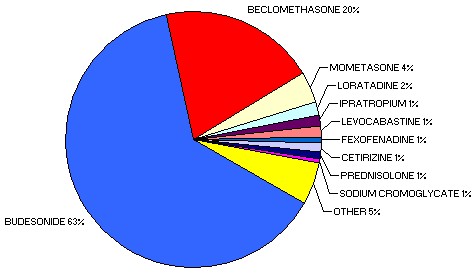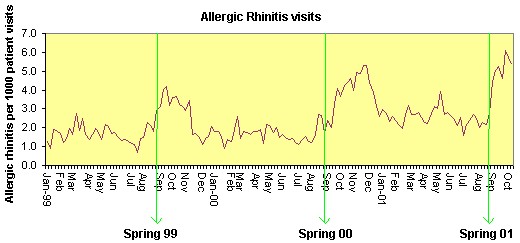Home
Article
Archive
2000 2001
Editor:
Neil Johnston
Columnists:
Rollo
Manning
Leigh Kibby
Jon
Aldous
Roy Stevenson
Brett Clark
Ken Stafford
Pat Gallagher
Heather Pym
Simon
Rudderham
Mark
Coleman
James
Ellerson
Terry
Irvine
Roundup
Peter
Sayers
[Home] [About The Newsletter] [Topics Covered] [Testimonials]
Issue 24 - 22nd October 2001
This week:
Disease Focus:
Allergic RhinitisDisease focus
Profile of Patients with Allergic Rhinitis
Top 10 medications for Allergic Rhinitis
Dosage and Regimen
Sources of information on Allergic RhinitisData Updates:
* Allergic Rhinitis surveillance
* Top 20 medications prescribed
*The GPRN is a national Australian database of general practice data, provided by participating GPs for research purposes. The data is: anonymous patient management information electronically collected from Medical Director users who have agreed to take part longitudinal with information dating back to 1 Jan 1999 updated on a weekly basisHealth Communication Weekly covers Up-to-date information on current issues in general practice, ways to use Medical Director (MD) more effectively, information on best practice,evidence-based medicine and topics that interest you.
email us at research@hcn.com.au
Click on the Newsletter Reader's Forum link to access a forum from which you can express your comment or viewpoint on this article.
The author values your input, so please take the time to register your details, and participate in the only free debate on the future of Australian pharmacy.
Registration is free, and required once only, for permanent access.
You do not need to register if you only wish to view comments.
Computachem Editor's Note:
We are pleased to announce that we have formed an alliance with Health Communications Network (HCN), an Australian company that is heavily involved in e-health. With permission, we have extracted focus items from their recent newsletter which should prove of interest to pharmacists.
Note that the second item, the top 20 prescriptions written by GP's is provided by the GPRN database noted above.
Disease focus
The focus of this week’s HCW is Allergic Rhinitis. This condition is the second most frequently self-reported condition in Australia1, with up to two million people experiencing symptoms of Allergic Rhinitis (or hay fever as it is commonly called).
HCW will also commence a weekly surveillance of numbers of patients attending their general practitioners with the condition. As an introduction in this issue, some data will be presented profiling patients with the condition.
1 Weiner JM, Abramsin Mj, Puy RM. Intranasal corticosteroids versus oral H1 receptor antagonistsin Allergic rhiniti:systematic review of RCTs BMJ 1998;317:12:1624-1629
Profile of patients with Allergic Rhinitis
Data used:
GPRN database
Data range: Prescriptions written and/or condition recorded as
Allergic Rhinitis between 1 Jan 1999 – 14th Oct 2001
Number of patients: 4,845
Top ten medications prescribed for Allergic Rhinitis patients
Number of patients: 10,003
Sex: 43% male 57% female
Age 9% patients aged less than 10
30% of patients aged 30-49 years
Top ten medications prescribed for Allergic Rhinitis patients

The majority
of prescribed medications were for nasal sprays (96%) with only 4% being
for oral preparations Loratidine, Fexofenadine and Cetrizine.
From this data we cannot quantify the level of OTC usage in these patients.
Dosage & Regimen of Budesonide
Table
1: Dosage & Regimen of Budesonide
There were 1,799 scripts for the most frequently prescribed medication,
Budesonide spray that included dosing information, the majority, (98%)
of which were for the higher strength 100mcg spray. The mean daily dose
of this formulation was 100mcg per day. The majority of patients were
prescribed the 100mcg spray at a regimen of 1 dose daily, (73.4%)
Medication name Doses Frequency No. of scripts % Budesonide nasal spray 100mcg/dose 1 Daily 1321 73.4% Budesonide nasal spray 100mcg/dose 1 Twice a day 262 14.6% Budesonide nasal spray 100mcg/dose 1 3 times a day 13 0.7% Budesonide nasal spray 100mcg/dose 1 4 times a day 1 0.1% Budesonide nasal spray 100mcg/dose 1 As directed 2 0.1% Budesonide nasal spray 100mcg/dose 1.5 Daily 50 2.8% Budesonide nasal spray 100mcg/dose 1.5 Twice a day 3 0.2% Budesonide nasal spray 100mcg/dose 2 Daily 74 4.1% Budesonide nasal spray 100mcg/dose 2 Twice a day 32 1.8% Budesonide nasal spray 100mcg/dose 3 Daily 7 0.4% Budesonide nasal spray 64mcg/dose 1 Daily 18 1.0% Budesonide nasal spray 64mcg/dose 1 Twice a day 6 0.3% Budesonide nasal spray 64mcg/dose 1.5 Daily 1 0.1% Budesonide nasal spray 64mcg/dose 2 Daily 9 0.5% Total 1799
Table 2: Number of GP visits per year for patients with Allergic Rhinitis
For the 4,845 patients identified as having Allergic Rhinitis, sufficient data was available to calculate the number encounters each patients had in a year for 4,507 patients (93%).
Note this may have been where a condition other than Allergic Rhinitis was being managed.
Two third of patients with Allergic Rhinitis were seen less than four times in a year. Note that patients who have <1 visit per year are those who could, for example, be seen once every 2 yearsNumber of GP visits/year n % <1 841 18.7 1 825 18.3 2 647 14.4 3 536 11.9 4 362 8.0 5-7 548 12.1 8-10 275 6.1 11+ 473 10.5
Sources of information on Allergic Rhinitis:
For GPs From the National Prescribing Service, an up-date on the management of Allergic Rhinitis
http://nps.org.au/Docs/pdfs/RhinitisPharmacyletter.pdf
An over-view of Allergic Rhinitis by Assoc. Prof. Ron Walls from the University of Sydney. He states that the prevalence of the disease has doubled over the past 25 years and presents some useful information on clinical presentation and management.
http://www.allergy.org.au/gpnews/vol1_no2/Rhinitis.htm
For patients
Within Medical Director, follow prompts for Patient Education leaflets as below:

Allergic Rhinitis surveillance
The chart below shows the rate of Allergic Rhinitis visits per 1000 up till 14 October 2001. A visit for Allergic Rhinitis is considered to have taken place if the GP has recorded either Allergic Rhinitis or hay fever as a diagnosis or has prescribed either Mometasone nasal spray or Ipratropium nasal spray. These two products were chosen as their indications are specifically Allergic Rhinitis and not for other Allergic conditions. Part of the challenge of attempting surveillance of this condition is that a large proportion of the treatments are available as over-the-counter preparations. Nevertheless it is reasonable to assume that for those patients requiring more aggressive therapy, GPRN data should reflect the seasonal nature of the condition.

Last data supplied: 14 October 2001 Data source: GPRN Health Communication Network Note this chart will feature in forth-coming issues, replacing Influenza surveillance
Top 20 Medications prescribed in General Practice this week
This Month Last Month This Year Generic medication Rank Percent Rank Percent Rank Percent Amoxycillin 1 3.63 1 4.2 4 2.72 Paracetamol/
codeine phosphate2 3.18 3 3.1 2 3.18 Temazepam 3 2.92 2 3.2 1 3.32 Paracetamol 4 2.90 4 3.0 3 2.99 Amoxycillin/potassium clavulanate 5 2.01 5 2.4 10 1.58 Cephalexin 6 1.84 8 1.9 6 1.82 Roxithromycin 7 1.72 6 2.0 13 1.37 Salbutamol sulfate 8 1.58 7 1.9 8 1.72 Celecoxib 9 1.54 10 1.6 5 2.00 Diazepam 10 1.54 12 1.5 7 1.72 Levonorgestrel/
ethinyloestradiol11 1.54 11 1.5 9 1.60 Rofecoxib 12 1.39 17 1.2 30 0.74 Mometasone
furoate
13 1.33 18 1.1 20 1.10 Doxycycline 14 1.31 13 1.3 19 1.12 Oxazepam 15 1.28 14 1.3 11 1.51 Simvastatin 16 1.25 16 1.2 14 1.28 Cefaclor
17 1.24 9 1.7 16 1.25 Atorvastatin 18 1.24 15 1.3 15 1.26 Chloramphenicol 19 1.24 22 1.1 24 0.93 Aspirin 20 1.20 21 1.1 21 1.08
This
month = four weeks ending 14 October 2001
Last month = four weeks ending 16 September 2001
This year = 15 September 2000 to 14 October 2001
Last data supplied: 14 October 2001
Data source: GPRN Health Communication Network
Editorial
Review:
Geoffrey Sayer * Dr Frank Pyefinch
Contributing Authors:
Fiona Horn * Leigh Hendrie * Kevin McGeechan * Geoffrey Sayer
Editor:
Alice Bhasale
Health Communication Network, PO Box 67 St Leonards NSW 1590 ph 02 9906
6633
email: research@hcn.com.au.
Back
to Article Index
Newsletter
Reader's Forum
The comments and views expressed in the above article are those of the author and no other. The author welcomes any comment and interaction, directly or via the Newsletter Reader's Forum links located at the top and bottom of each article.
The newsletter archives are now fully searchable via the search engine on the left hand side of this page. If you would like to find similar articles to the above material, please enter the appropriate keyword(s). To retain context with multiple keywords or phrases, please enclose in inverted commas.
Please contact us if you would like further information or would like us to research additional material to publish as future articles.
Don't forget to advise of any change in your e-mail address so that your subscription may be continued without interruption.
Letters to the editor are encouraged, or if you have material you would like published, please forward to the editor.
Any interested persons who would like to receive this free newsletter on their desktop each fortnight, please send a single word e-mail "Subscribe"*
If you have found value in this newsletter, please share it with a friend, or alternatively, encourage a colleague to subscribe
neilj@computachem.com.au
Why not try (and bookmark) the
Computachem Interweb Directory
for an easily accessed range of medical and pharmacy links, plus a host of pharmacy relevant links.
The directory also contains a very fast search engine for Internet enquiries. You may also access the Home Page at:
http://www.computachem.com.au
Back to Article Index
Article
Archive 2000
Article
Archive 2001
Home

